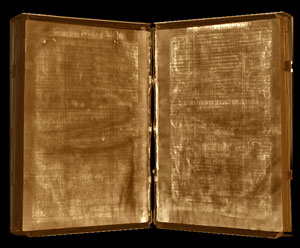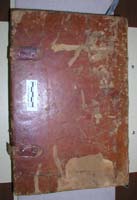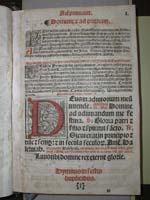Psalterium, An[t]iphonarium Sanctorale cum Psalmis & Hymnis printed in Mexico in 1584 by Pedro Ocharte.
Pedro Ocharte was the printer of this volume and the third printer in Mexico. He married the daughter of the first printer, Juan Pablos, and rented the printing press from the widow of Pablos. He is also known because he was imprisoned during the Mexican Inquisition for printing Lutheran statements against the veneration of saints. He continued to run his press from prison, though, with the help of his wife. Since this volume is religious in nature and printed after his release from prison, we have speculated for which, if any, religious faction it was printed. While not wholly agreed upon, it seems possible that the Jesuits would have commissioned it because they were developing several colleges at the time and it would have been used for religious instruction.
Boards, Board Attachment, Covering
|
The binding is reddish-brown, vegetable tanned sheepskin over quarter-sawn oak boards, 1 cm thick at their widest and 3mm thick at the thinnest. The boards were beveled on the inner and outer faces at the head, tail, for edge and spine sides. The boards have slight back-cornering and evidence of a lacing channel for an endband is visible on the front board at the head but no evidence of the endband exists. Two leather straps are present but broken on the fore edge with the middle portion missing. Coarse twine supports, not part of the original sewing, have been laced into the boards. |
Textblock
|
The text paper is handmade, antique laid. The weight varies between medium weight and heavy weight throughout the book and is cream colored. No watermarks are visible. Many pages are smooth from much handling as well as from a slight waxy build-up. Many pages have drops of wax covering the page and some pages also have a slightly gritty feel, possibly incense. The condition of the pages varies greatly. There is slight foxing, surface dirt, and staining throughout the text. The text block has been severely and unevenly trimmed. On some pages the page number has been completely cut off, and on others, it is half cut off. There is a heavy crease, probably either from the printing or overly tight sewing, that runs throughout the text block and has caused some minor tearing on individual pages. |
Endleaves
The endleaves are different from the rest of the text. They are of a lighter weight and whiter handmade, laid paper with visible watermarks. After consulting with the conservator at LC, it seems that the text block may be paper from the Netherlands, the endsheets from France.
Media
The media present are black and red printerís ink (cinnabar?), iron-gall ink, possible cochineal that was applied by hand, and graphite. Woodcuts are present throughout the volume. The type impression was quite heavy. In places printing easily shows through from the opposite side of the page.

About the Species
This specimen was made available to the University of Texas High-Resolution X-ray CT Facility for scanning by Dr. Ellen Cunningham-Krupta of the School of Information, The University of Texas at Austin. Funding for scanning and image processing was provided by a National Science Foundation Digital Libraries Initiative grant to Dr. Timothy Rowe of the University of Texas at Austin.
The antiphonal was scanned inside its storage case. For the renderings shown here, the book was digitally 'cracked open' to reveal the pages inside. The ink on the pages is visible in these renderings because it contains iron, which attenuates X-rays.

About this Specimen
This specimen was scanned by Richard Ketcham on 1 April 2003 along the long axis for a total of 391 slices. Each 1024 x 1024 pixel slice is 1.0 mm thick, with an interslice spacing 1.0 mm and a field of reconstruction of 275 mm.

About the
Scan
Literature
& Links
Front page image.
|  |

Additional
Imagery
|










